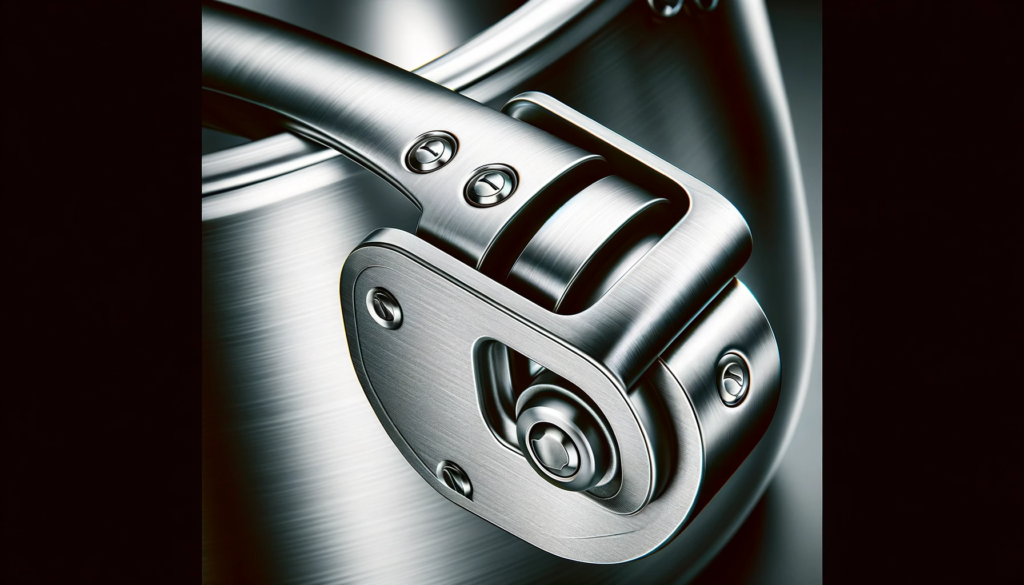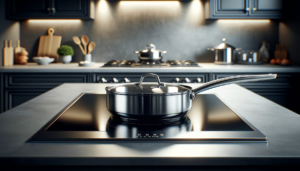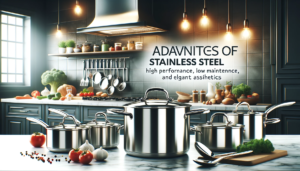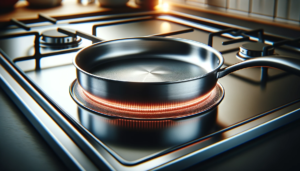Have you ever reached for a pan on the stovetop and felt the startle of an unexpectedly hot handle? Stainless steel is ubiquitous in kitchens today, but its thermal conductivity properties may surprise you.
Stainless steel handles can get hot during cooking under certain conditions, but are generally safe to briefly grip and maneuver with bare hands for typical stovetop and oven scenarios provided some basic precautions are followed.
Let’s examine why stainless steel handles heat up differently than other metals, what design factors keep them cooler, and some simple tricks to prevent burns from pans pulled straight from a hot oven.
Do Stainless Steel Handles Get Hot?

Generally, quality stainless steel handles are designed and engineered to remain cool enough for brief handling during typical cooking tasks.
Their lower thermal conductivity combined with insulated constructions prevents severe heating that could burn skin on contact.
However, exceptions exist where stainless handles grow hot enough to warrant potholder use – mostly involving extended contact after prolonged oven cooking.
Specific handle builds, stove settings, and usage durations impact warming.
But in most cases, stainless steel’s properties permit temporarily grasping handles safely sans protection while moving cookware.
We’ll explore the heating dynamics and ideal handling best practices more below.
Stainless steel handles on pots, pans, and other cookware are generally designed to stay cool enough to briefly touch and maneuver during routine cooking activities.
The lower ability of stainless steel to quickly conduct heat, along with insulated handle constructions, helps prevent handles from reaching temperatures that could burn skin upon contact.
However, there are some exceptions where stainless steel handles can get hot enough over time to require using potholders.
This typically occurs in situations involving prolonged oven cooking which allows extended contact between the hot cookware and handle.
The specific design of the handle, the level of heat being applied, and the total duration of cooking impact how hot a stainless steel handle can become.
But in most common cases of moderate heat exposure and reasonable cooking lengths, stainless steel as a material allows people to briefly pick up a hot pan handle with bare hands safely without gloves or hot pads.
We will go over more details below on why stainless steel behaves this way when heated and examine best practices for safely handling hot cookware.
What is Stainless Steel?
Stainless steel is an alloy, meaning it is a metal made up of a combination of other metals.
Specifically, stainless steel is typically composed of iron alloyed with chromium and nickel.
The chromium reacts with oxygen to form a thin layer of chrome oxide on the surface that prevents rust, staining and corrosion.
This is what gives stainless steel its notable durability and aesthetic shine.
Stainless steel is valued for kitchen appliances and cookware because of properties like corrosion resistance, strength, longevity and ease of cleaning.
Common appliances like refrigerators, dishwashers, ovens and ranges often feature stainless steel components and finishes.
Additionally, many pots, pans, kettles and bakeware intended for cooking are made entirely from stainless steel or utilize it for surfaces.
With its sleek appearance and lasting finish, stainless steel is popular for architecture like buildings and monuments.
Automakers also employ stainless steel for its resilience to the elements.
Overall, stainless steel provides an attractive, sanitary and low-maintenance material suitable for many applications.
However, despite its virtues, stainless steel conducts heat differently than other metals utilized for kitchen handles and cookware.
Stainless steel by definition is a steel alloy containing chromium and sometimes nickel in addition to iron.
The chromium mixes with oxygen on the stainless steel’s surface to form a durable, protective oxide layer that resists corrosion, rust, and staining.
This oxide layer gives stainless steel its signature smooth, shiny appearance and helps it hold up well over time.
In a kitchen setting, stainless steel is valued for the corrosion resistance that allows easy cleaning.
It also has strength to withstand cooking demands and a pleasing aesthetic that fits modern appliances.
Many major kitchen appliances like refrigerators, dishwashers, ovens, and ranges incorporate stainless steel parts or finishes.
Additionally, stainless steel is frequently used to construct pots, pans, kettles, baking sheets and other vessels intended specifically for cooking tasks.
Beyond the kitchen, stainless steel is also useful for architecture and transportation purposes due to its ability to maintain its appearance despite environmental exposures.
However, despite having many beneficial properties, stainless steel differs from other metals in how it conducts heat.
The alloying elements like chromium and nickel that give stainless steel such versatility also change how it absorbs and conveys thermal energy during cooking compared to metals like copper or cast iron.
We’ll look closer at why this matters for stainless steel pan handles next.
Heat Conductivity of Stainless Steel

Compared to metals like aluminum, copper, cast iron and carbon steel, stainless steel is an inferior heat conductor.
The chromium and nickel alloys that make stainless steel resistant to corrosion and rust also inhibit rapid heat transfer.
Essentially, stainless steel does not get hot as quickly as those denser, purer metals when exposed to high temperatures.
This makes stainless steel well-suited as a buffer material between the extremely hot surfaces of pots and pans during cooking and the handles meant for lifting those vessels.
Heat conductivity can vary greatly even between different stainless steel alloy grades.
Austenitic stainless steels typically used for kitchen products have relatively low thermal conductivity.
But higher grades of stainless steel designed for more temperature-resistant applications in fields like aerospace exhibit increased heat conductivity approaching that of mild steel or cast iron.
So while stainless steel handles lag behind other metals in transferring surface heat from cookware, not all stainless alloys have equivalent properties.
The exact composition of the steel impacts its thermal dynamics noticeably.
Compared with very heat-conductive metals like aluminum, copper, cast iron, and carbon steel, stainless steel conducts heat relatively poorly.
The chromium and nickel added to stainless steel to help prevent corrosion also reduce how quickly it transmits heat.
Essentially, stainless steel does not absorb heat from a source as readily as denser, purer metals on a per mass basis when exposed to the same high temperature.
This makes stainless steel suitable to use as a buffer material separating the extremely hot cooking surfaces of pots and pans from handles meant for lifting them that need to stay cooler for brief hand contact.
It should be noted though that even among different stainless steel alloys, thermal conductivity can range quite widely.
The most common austenitic stainless steels used for kitchen items have very low conductivity.
But higher grades of stainless steel alloys engineered for intense heat applications like rockets can approach heat conductance closer to mild steel or cast iron while retaining corrosion resistance.
So while as a category, stainless steel handles stand apart from handles made entirely from metals like aluminum that easily grow hot, not every stainless steel alloy performs identically when it comes to resisting temperature increases.
Depending on factors like alloying metals andcrystal structure, stainless steels can differ noticeably from one another in how readily they channel heat from one place to another.
This variability means that the exact composition of a stainless steel handle impacts how prone it is to heating up from an attached cooking pot.
Factors That Impact Handle Temperature
How readily a metal handle heats up depends on variables beyond the inherent thermal conductivity of the material used, too.
Thicker, more insulated handles, especially those with rubberized coatings for grip, provide a buffer between hot pans and hands.
Many handles attach via rivets or screws that isolate the metal bracket from heating surfaces as well.
Composite handles combining stainless steel structural frames with softer grips do not transmit as much heat either.
Even solid stainless handles minimize risks if sized and shaped appropriately to allow graspable areas distant from cooking surfaces.
Additionally, the length of cooking time and level of heat applied influence handle warming.
Boiling water for pasta on a stove top transfers less thermal energy than baking casseroles at high temperatures for an hour.
Leaving stock pots to simmer all afternoon lets handles grow hotter than brief searing or sautéing tasks.
And the quantity of food inside cookware contributes too.
Packed vessels require stronger burners and retain more warmth than sparsely filled ones.
Monitoring handles frequently helps prevent inadvertent burns regardless of material.
But in typical, reasonable cooking scenarios of moderate heat and duration, stainless steel handles often avoid becoming too hot to handle safely without gloves or pot holders.
Beyond just the inherent thermal conductivity of the metal itself, other physical factors impact how hot stove and oven handles can become during cooking.
Thicker, well-insulated handles that incorporate materials like rubber for grip create a buffer between hot pans and hands that reduces heat flow.
Many handles also attach to cookware via rivets or screws rather than direct welding, putting some space between the handle bracket and heating surface.
Composite handles that combine a stainless steel interior arm for structure with softer outer silicone, rubber or plastic coatings also do not transmit heat as readily.
But even solid stainless steel handles can be shaped and sized appropriately to allow cool grippable areas at a distance from pots to minimize risks as well.
Operating conditions also majorly influence handle warming.
Boiling water for pasta transfers far less heat energy compared to baking a casserole at very high oven temperatures for an hour.
Letting a stock pot simmer all afternoon allows more handle heat buildup than quick searing or sautéing tasks only lasting minutes.
And cookware holding large amounts of dense food requires more intense burner settings and retains more thermal inertia compared to lightly filled vessels.
Frequently checking handles remains wise to prevent inadvertent burns regardless of material.
But under typical usage of reasonable cooking lengths and medium heat applications, stainless steel handles often stay cool enough for brief handling without requiring gloves or potholders.
Differences Between Cookware Handles

Contrasting stainless steel handles against other common handle materials clarifies their heat-resistant qualities.
Traditional cast iron skillets and pans feature metal handles of the same material that grow dangerously hot upon stovetop or oven use absent potholders.
Even non-stick cookware like ceramic and enameled vessels usually have metal handles subject to heating.
So solid stainless handles offer better insulation than these types more prone to heat absorption.
Alternatively, some cookware handles made from composites like Bakelite, silicone or wood reduce risks because non-metals transmit less thermal energy.
Certain newer pans utilize specially designed plastic handles touting insulation technology making them cooler to grip.
Many stainless steel cookware handles bolster low conductivity with innovative constructions preventing excess heating.
Riveting a handle to the pan body instead of welding provides a degree of separation from the heat source into the steel part.
Sometimes ridges texturize handles to mitigate heat transfer by minimizing direct flush contact.
And hollow open spaces behind the exterior handle facade create air gaps impeding temperature transmission further.
Other handles injection mold a combination steel interior support arm into softer exterior silicone, rubber or plastic grips more akin to heat-resistant composite construction.
Comparing stainless steel handles to other materials commonly used for pots and pans clarifies why stainless steel options offer better heat resistance in most cases.
Traditional cast iron pans are made entirely of very thermally conductive cast iron that gets extremely hot all over when cooking on the stove or in the oven.
So cast iron’s metal handles rapidly reach temperatures far too hot to ever touch with bare hands while the pan is being used for cooking.
Most non-stick ceramic, enameled, or even standard aluminum pans also rely on all-metal handles that readily absorb and transmit surface heat.
Stainless steel handles provide notably better insulation against heating compared to these types of all-metal handles prone to dangerous levels of heat absorption.
Alternatively, some modern cookware handles are constructed from materials like Bakelite plastic, silicone rubber or wood that, being non-metals, transmit less heat energy through conduction.
Newer pans also increasingly utilize proprietary plastics touted as having insulating technology to better maintain cooler grippable temperatures.
So while stainless steel already improves over cast iron or aluminum handles, these composite materials reduce risks even further by being intrinsically less thermally conductive.
Stainless steel handles can also utilize smart constructions to prevent excess heating beyond just using stainless steel as the base material.
One common method is attaching handles to pans via rivets or screws instead of directly welding them.
This puts a very small air gap between the steel handle bracket and the hot pan surface that impedes heat transfer slightly.
Ridged or textured handle shapes instead of completely flush smooth surfaces also reduce heat absorption somewhat.
Hollow handles can feature internal voids and air channels behind the exterior steel facade further hampering heat transmission into areas to be gripped.
And some handles injection mold harder inner stainless steel structural supports inside a softer silicone, rubber or plastic external grip layer reminiscent of composite construction.
So stainless steel handles can employ multiple clever design choices to avoid heating up excessively in addition to stainless steel being moderately thermally insulating intrinsically.
Conclusion
In conclusion, stainless steel on its own is not an excellent heat conductor and can provide a buffer between hot cookware and handles.
But many factors like handle design, cooking duration and stove settings impact overall handle warming too.
With quality insulated constructions and careful heat modulation, stainless steel handles typically avoid reaching dangerous temperatures during everyday cooking tasks.
But potholders may still be warranted as a precaution for prolonged oven use.
To summarize key points, stainless steel as a material has relatively poor thermal conductivity, meaning it does not readily absorb and convey heat.
This allows it to act as an insulating barrier between extremely hot pans and handles that need to remain cool enough to briefly grip safely.
But handle heating depends on more than just the metal used.
Insulative handle constructions, prudent stove heat settings and reasonable cooking lengths also keep handles from getting too hot in typical use cases.
Thoughtfully designed stainless steel handles avoid excess heating in most normal cooking scenarios.
But for extended oven use, potholders may provide a prudent precaution to prevent burns from accumulated handle heat, even on stainless steel cookware.



